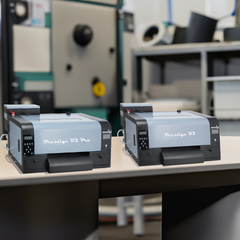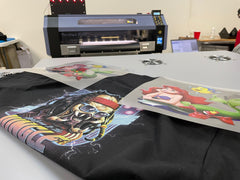A number of the ink manufacturers participating in this year’s showcase also submitted troubleshooting information detailing how to better get along with their products, and plastisol ink in general. Some of the submissions dealt with the same or similar troubles (dye migration, for example), but we decided to include some of that duplication, as not only positive reinforcement, but for the benefit of slightly different takes on addressing similar problems.
Problem: I am using an additive to turn my plastisol ink into a discharge ink, but am not getting vibrant colors after they come out of the dryer. What am I doing wrong?
Solution: There are several variables which could be causing your lack of success.
1. Are you sure the shirts you are using are dischargeable? Some manufacturers still use non-reactive dyes in their shirts, which will not discharge; only shirts dyed with reactive dyes are dischargeable.
2. Is the shirt 100 percent cotton? If not, it will not discharge properly.
3. Is your combination of the discharge additive and discharge agent correctly mixed? Check your ink manufacturer’s technical data sheet to see what percentage of the additive and agent it suggests for the product, then make sure you accurately weigh this into your mixture and stir thoroughly.
4. What is your temperature and dwell time of the shirt going through your conveyor dryer? The discharge process is a time-and-temperature process which requires a certain amount of heat and time in the dryer. The time is especially critical. Some ink makers require 320°F for 90 seconds to insure the best results. Again, check with your ink manufacturer to determine the correct temperature and time.
5. If you are using a discharge additive, is the additive compatible with the ink into which you are mixing it? For example, if you are using Brand-A ink and Brand-B discharge additive, the two may be incompatible and not only will you not get the results you are looking for, it will not mix together well either.
—Submitted by Union Ink,
Ridgeield, N.J.
Problem: I’m experiencing dye migration when printing white or light ink on dark 100 percent polyester.
Solution: It is important to recognize the many factors you can control when screen printing dark 100 percent polyester material. Dryer temperature and speed, ink selection, and ink deposit are the easiest for a screen printer to control. You may have some control over factors such as garment manufacturer, number of print locations, and the number of colors. When printing polyester it is best to keep the conveyor dryer at a lower temperature with a slower belt speed. The dye in polyester garments has a tendency to bleed at higher temperatures. Remember to always select a low-bleed polyester ink when printing these garments; standard T-shirt inks will often bleed on dark polyester material. It is also important to note that the print may not show dye migration immediately out of the dryer. Sometimes the ink will begin to change color hours or even days later. Ink deposit is also important when working with polyester. For a thick ink deposit, screens should be an 86 or 110 mesh count and squeegees should have 70-durometer blades. Keeping your customer informed about the possibility of polyester dye migration can also help prevent some of these problems. The more they know when specifying garments, the more likely they are to choose higher quality materials and fewer print locations.
—Submitted by One Stroke Inks,
Louisville, Ky.
Problem: What causes my plastisol ink to wash out when laundered?
Solution: The most common reason for wash-out is undercure. The ink film must reach the temperature recommended by the ink manufacturer in order to achieve a total cure. Most plastisol inks must reach a temperature of 320°F. It is important that the ink film itself reaches that temperature. Dryer readouts and temperature- strip readings from the garment do not ensure that the ink is reaching the required temperature.
Problem: What causes my ink to crack in the wash?
Solution: Again, the most common culprit is undercuring. Wash-out usually occurs with thin deposits of ink, whereas cracking is common on thick, undercured ink deposits. Test the ink film to make sure it is reaching the cure temperature recommended by the ink manufacturer.
Problem: Why does my print fade when laundered?
Solution: Ink wash-out can give the appearance of a fade, but the most common cause of fading is fibrillation or fiber show-through. This condition is caused by the shirt fibers pushing through a thin ink deposit, creating an illusion of fading. Thicker deposits of ink or a clear overprint will reduce the effects of fibrillation.
Problem: Why doesn’t the ink always adhere to the garment?
Solution: In the case of total separation of ink from the substrate, two reasons are most prevalent: undercure and incorrect ink selection. Different substrates require different ink or ink preparation in order to ensure good adhesion. Refer to the recommended-substrates portion of your ink manufacturer’s technical information for more information.
Problem: How do I test my dryer for a good ink cure?
Solution: The ultimate goal of your dryer is to bring the ink film to the cure temperature recommended by the ink manufacturer. With this in mind, the best way to test it is to take a temperature reading of the ink itself, either by using a thermo-probe with the crosshairs placed directly in the ink, or temperature strips placed in the wet ink before it passes through the dryer.
—Submitted by Willex/Div. of PolyOne
Keenesaw, Ga.
Problem: I printed some maroon polyester bowling shirts with a white design. The customer just brought them back because the design had gone pink.
Solution: Dye migration or bleeding occurs on polyester garments when the disperse dye in polyester fiber is heated to temperatures in excess of 265°F causing it to sublimate. The dye actually changes from a solid to a gas. When plastisol inks are cured at temperatures higher than 265°, these dyes are released into the ink causing a discoloration in the ink film. Higher temperatures cause more severe migration, so avoid curing temperatures above 320°F. For example, a red 100 percent polyester shirt is printed with a standard white plastisol and cured at 320°F. The white ink begins to turn pink. Note that the migration may not become noticeable for 24 to 48 hours depending on the ink deposit or the quality of the dye used in the garment. To avoid these affects, print with a quality low-bleed ink, or a “dye-migration blocker” as an underbase, when printing on 100 percent polyester or polyester performance textiles. The type and color of the dyes in the garment can allow one product to work better than another, so testing new fabrics, new colors, and new lots is highly recommended, according to the following procedure:
- Test for migration by printing the fabric with enough white to insure complete coverage. This is normally printed through at least a 110-tpi mesh. Print/ lash/print may be necessary to insure enough ink for 100 percent coverage.
- Cure the white ink in a dryer that is calibrated to insure that a temperature of 320°F is achieved on the garment. Note: This should not be confused with a dryer setting of 320°F, but a measured temperature on the garment.
- Cut the print in half. Place half in a convection oven or a warm place to elevate its temperature to 125°F for 15 hours. This accelerated heat-aging test will simulate several weeks of normal aging.
- Place the heat-aged sample beside the control sample to compare the differences in ink color.
—Submitted by Rutland Plastic Tech.,
Pineville, N.C.
Problem: My customer reported that every shirt has a very faint image on the back that’s exactly the same as what we printed on the front! How does this happen, and how can I avoid it?
Solution: Ghost images can appear on 100 percent cotton shirts after they are cured through the dryer. The problem is usually associated with the choice of white ink. Certain low-bleed inks, for printing on polyester or 50/50 blends, are formulated with some sort of dye-blocking agent, which can actually have a bleaching effect to cotton dyes if shirts exit the hot oven and are stacked on top of one another before cooling. The back of a shirt sitting on top of the printed front of another shirt can develop a ghost image of the print. To prevent this from happening it is recommended to use either a white ink designed for 100 percent cotton shirts, or a low-bleed ink warranted against worries of ghosting problems.
Problem: I put a printed garment into my dryer and immediately the printed inks changed color. What’s going on?
Solution: This is called dye-sublimation— the garment dyes, under heat, are sublimating (that is, turning into a gas) up through the ink film. While it’s one of the hardest to correct it is perhaps the easiest of problems to see, as it manifests itself immediately. The simplest way to avoid dyes becoming aggressive is to cure the inks at a lower temperature. The ideal temperature at which to cure plastisol inks on troublesome polyester or polyester- blend fabrics is between 290-310°F. By curing at such lower temperatures you will minimize the dye’s ability to sublimate. As this is not the normal curing temperature for general-purpose plastisol, you must ensure that you are using an ink specially formulated to cure at lower temperatures.
Problem: I’ve had dye-migration and bleeding, but the white ink has always shown a pale version of the shirt color. Well, the other day, I printed white on black shirts, and the ink picked up a yellowish-green color. Disgusting! What happened?
Solution: This is likely the result of overdyed garments. It’s not uncommon for a garment maker to overdye a batch of lighter-colored garments (that aren’t selling) with a darker color (usually black). The original dye color is still there, though, and your standard procedures for dealing with dye-migration and bleeding are appropriate to keep it from appearing. Good luck and remember: “Ink Doesn’t Think!”
—Submitted by Lancer Group Int’l.,
Winnipeg, MB
Problem: Do I need an adhesive additive for printing plastisol onto polyester garments?
Solution: The answer is no. Plastisol ink will adhere to polyester substrates without the aid of catalysts or additives. Introduction of catalysts or additives will reduce the bleed-resistance of the ink. Polyester garments will bleed unless printed with pure bleed-resistant inks. Be sure to check the label on the garment before you proceed with the print. Many substrates look similar, but they require different print parameters.
Problem: Do I need an adhesive additive for plastisol on nylon substrates?
Solution: In most cases, the answer is yes. A catalyst must typically be added to the plastisol to ensure a stronger adhesion to the substrate. In the case of woven nylon bags, look for a product that does not require a catalyst when printed on nylon substrates with a heavy texture. However, these materials may be treated for waterproofing, in which case the coating must be removed before printing and a catalyst added to the ink. Be sure to check the label on the garment before you proceed with the print.
Problem: What can I do to improve opacity?
Solution: Ink selection is very important. Be sure that the product you choose is listed as an opaque ink. However, selecting an opaque ink will not ensure a totally opaque print. Factors such as print parameters and screen preparation contribute to achieving maximum opacity. When printed correctly, thicker stencils on screens will allow greater amounts of ink to be laid on the surface of the garment. The most effective way to print is with a hard flood that fills the stencil space completely, and a low-pressure print stroke with a hard, square-edge squeegee. This print method allows the ink to remain on the surface of the substrate, as opacity is greatly diminished if the ink is driven into the substrate.
Problem: Are there different types of plastisols for different types of substrates?
Solution: Yes. Polyester fabrics need bleed resistance, nylon fabrics need better adhesion qualities, lycra needs an ink with great elongation and so on. Though it would be nice to print with a do-all ink, the properties of the different substrates make it impossible to create such a product. You must know your substrate, then research the ink line you would like to use.
—Submitted by Willex/Div. of PolyOne,
Keenesaw, Ga.
Problem: I’m concerned that, in my search for a plastisol ink of “creamy” consistency to facilitate my manual printing, I may be shooting myself in the foot given the significantly more demanding conditions on my automatic presses. Is there a middle ground?
Solution: The correct body type of a plastisol ink is highly thixothropic while sitting in stock and of smooth, pseudoplastic viscosity throughout the mixing and shear stress of automatic printing. It is our recommendation to obtain plastisol inks formulated with state-of-the-art resin formulations to stand still under many different circumstances of printing jobs.
—Submitted by Goteks USA,
Atlanta, Ga.
Reprinted from Printwear Magazine November 2008 ©2008 National Business Media, Inc. All rights reserved.




